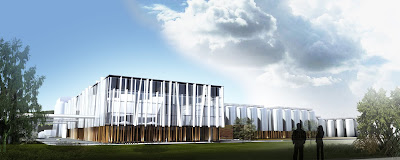
A Continuación el Prólogo:
SUSTAINABILITY
SUSTAINABILITY
Global warming and the energy crisis are topics of great current significance and there is no doubt they are foremost in the minds of world leaders and authorities, and in public opinión in general. Sustanaibility is an issue that has come to the fore, although it is still not clear what this concept implies and weather it can be applied to all fields. What is important is awareness of this problems and how architecture can provide efficient response in a globalized world.
Can we claim that sustainable architecture exists for us to be able to respond to the demands of society? I have my doubts. Discourse seems more important than convictions right now. Only real demand coming from society can bring about large-scale research and, consequently, drive us towards changing the current situation.
It is an undeniable fact that architects are presented with opportunities when it comes to creating our designs. We have the real and unavoidable responsibility to solve these problems in the measure of our technical and economic resources.
Nations face a very different reality. Some are equipped with technical and economic advantages, but also drawbacks, such as the lack of fossil fuel resources (oil and gas) and the high costs involved in satisfying demands for development. However, this disadvantadge can be turned to our advantage as it provides an OPPORTUNITY to use our imagination and find substitutes in passive energies, and other forms of energy that climate and nature have blessed us with.
Bioclimatic systems are alternatives that contribute to protecting the environment, saving energy, and improving our quality of life. If we observe the ingenious solutions achieved by local architecture in different areas of the planet, we will have greater success and come that much closer to finding the appropriate solutions in our designs, which does not mean overlooking other solutions in this broad field of research.
The use of geothermal and wind energy systems to condition large industrial sites has produced good results in recent projects in a number of countries that are now at the international cutting edge (as is the of Chile in South America). These projects have achieved remarkable energy efficiency levels compared with what had normally only been empirical exercises. Owing to their large size, industrial buildings permit interior to be controlled more effectively; they use more energy and production costs accurately reflect this use.
Dwellings involve other complexities, and finding new solutions to them has become a matter of urgency. A large number of sustainable dwelling projects are being with sustainability parameters that range from the use of passive systems (solar energy and light, natural ventilation, etc.) to more complex technologies, such as computerized systems for solar shades on façades and the quest for greater energy self-sufficiency. Homes have different variables, such as size, location, and end use, influenced by different customs and cultures.
Development of dwellings must combine many qualities: they must adequately satisfy demand, provide solutions to the setting (urban and geographical environment), seek beauty and rational use of resources (natural, material and economic resources), respect cultures, and provide quality of life to people.
Architecture can offer imaginative responses to the challenges bought by global warming, and should be developed in a responsible manner by taking into account the problems facing the planet and attempting to produce the least impact on the environment and the immediate surroundings.
Guillermo Hevia H.
























 Estamos de vuelta con nuestro blog y
Estamos de vuelta con nuestro blog y 

